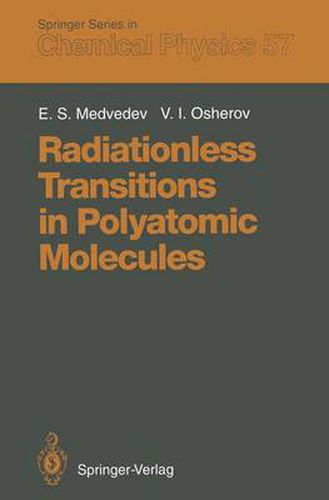Readings Newsletter
Become a Readings Member to make your shopping experience even easier.
Sign in or sign up for free!
You’re not far away from qualifying for FREE standard shipping within Australia
You’ve qualified for FREE standard shipping within Australia
The cart is loading…






This title is printed to order. This book may have been self-published. If so, we cannot guarantee the quality of the content. In the main most books will have gone through the editing process however some may not. We therefore suggest that you be aware of this before ordering this book. If in doubt check either the author or publisher’s details as we are unable to accept any returns unless they are faulty. Please contact us if you have any questions.
Radiationless transitions comprise an important class of physical phenomena occurring in the excited states of molecules. They affect the lifetimes of the ex cited states and govern primary photochemical and photophysical processes. Much effort has been devoted to the understanding of radiationless transi tions. Still, owing to recent advances, the field continues to attract attention. The demand for a book on the theory of these processes naturally arises in at tempting to comprehend a large body of literature, as the famous review article by K. F. Freed and the book by R. Englman do not encompass some issues of current interest. Our intent is to highlight the underlying physical principles and methods in such a way that the book both in its content and its presentation is instruc tive for a wide audience. The basic ideas are treated in simple mathematical terms intelligible to ex perimentalists and to readers unfamiliar with the field. Complicated theoret ical methods are always expounded from first principles, so that a knowledge of quantum mechanics and mathematics at the graduate-student level will enable the reader to easily follow the derivations. Experts will find efficient methods of calculating the transition rates, as well as new applications of quasiclassical methods and fresh treatments of standard problems. Details of measurements are not discussed, and experimental data are only invoked to illustrate the theory.
$9.00 standard shipping within Australia
FREE standard shipping within Australia for orders over $100.00
Express & International shipping calculated at checkout
This title is printed to order. This book may have been self-published. If so, we cannot guarantee the quality of the content. In the main most books will have gone through the editing process however some may not. We therefore suggest that you be aware of this before ordering this book. If in doubt check either the author or publisher’s details as we are unable to accept any returns unless they are faulty. Please contact us if you have any questions.
Radiationless transitions comprise an important class of physical phenomena occurring in the excited states of molecules. They affect the lifetimes of the ex cited states and govern primary photochemical and photophysical processes. Much effort has been devoted to the understanding of radiationless transi tions. Still, owing to recent advances, the field continues to attract attention. The demand for a book on the theory of these processes naturally arises in at tempting to comprehend a large body of literature, as the famous review article by K. F. Freed and the book by R. Englman do not encompass some issues of current interest. Our intent is to highlight the underlying physical principles and methods in such a way that the book both in its content and its presentation is instruc tive for a wide audience. The basic ideas are treated in simple mathematical terms intelligible to ex perimentalists and to readers unfamiliar with the field. Complicated theoret ical methods are always expounded from first principles, so that a knowledge of quantum mechanics and mathematics at the graduate-student level will enable the reader to easily follow the derivations. Experts will find efficient methods of calculating the transition rates, as well as new applications of quasiclassical methods and fresh treatments of standard problems. Details of measurements are not discussed, and experimental data are only invoked to illustrate the theory.